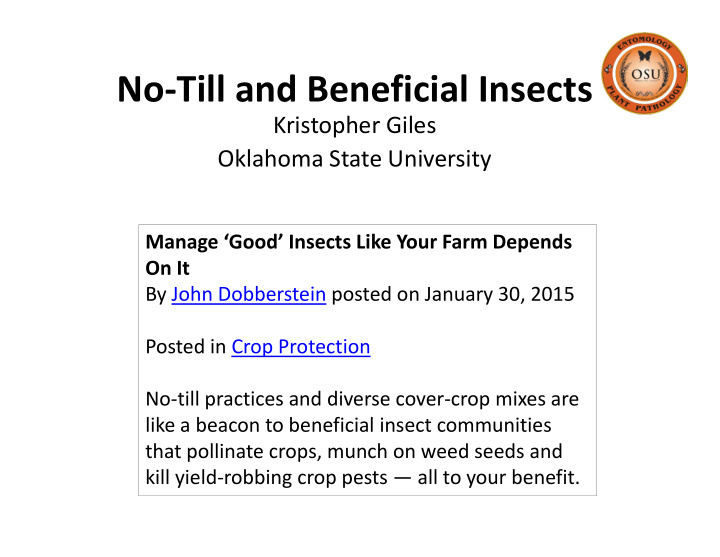



No ‐ Till and Beneficial Insects Kristopher Giles Oklahoma State University Manage ‘Good’ Insects Like Your Farm Depends On It By John Dobberstein posted on January 30, 2015 Posted in Crop Protection No ‐ till practices and diverse cover ‐ crop mixes are like a beacon to beneficial insect communities that pollinate crops, munch on weed seeds and kill yield ‐ robbing crop pests — all to your benefit.
No ‐ Till and Beneficial Insects *Predators and parasites of pests and *Pollinators
No ‐ Till Pests The Bad News! Wheat: Hessian Fly, Mites, Wireworms, White Grubs.
No ‐ Till Pests The Bad News! Wheat: Hessian Fly, Mites, Wireworms, White Grubs. Corn / Sorghum: Cutworms, Borers
No ‐ Till Pests The Bad News! Wheat: Hessian Fly, Mites, Wireworms, White Grubs. Corn / Sorghum: Cutworms, Borers Cotton / Soybeans: Cutworms, Grasshoppers
No ‐ Till and Predators / Parasites The Good News! On Farms: 1699 / 1700 insect species not pests Wheat: Almost always higher and reduce pests Cotton: Often higher and reduce pests Corn / Sorghum: Occasionally higher and reduce pests Soybeans / Canola: ??
No ‐ Till and Predators / Parasites We know how it works: Reliable food webs = fields remain alive * Increased organic matter * Higher decomposer #’s * Higher Predator #’s Generalists * Consistent Predator #’s Soil / Ground dwellers Weed seed eaters! Active at night
How it works in Winter Wheat in Oklahoma No ‐ Till Wheat * No ‐ Till fields support higher #’s of beneficial insects year ‐ round * Hessian flies managed by high yielding resistant varieties * Fewer aphids colonize soil with residue, and low #’s are sheltered Aphids and other potential pests killed by generalist predators Aphids killed by specialist parasitoids that depend on pasture
No ‐ Till and Pollinators Adult Hover Fly = Pollinator Larval Hover Fly = Predator
No ‐ Till and Pollinators Wild bees
No ‐ Till and Pollinators Wild bees * Dozens of wild bee species in Oklahoma * Some studies have shown they are better pollinators than Honey bees Adapted to local environments: pollinate throughout day Survive better, especially in minimally disturbed soil
Conserving wild bees 70% are soil nesting * No ‐ Till fields support wild bees *Pastures support wild bees *Shrubs support wild bees *Selective insecticide use *Diverse farming landscapes support wild bees
No ‐ Till and Beneficial Insects Manage ‘Good’ Insects Like Your Farm Depends On It By John Dobberstein posted on January 30, 2015 Posted in Crop Protection No ‐ till practices and diverse cover ‐ crop mixes are like a beacon to beneficial insect communities that pollinate crops, munch on weed seeds and kill yield ‐ robbing crop pests — all to your benefit.
Recommend
More recommend